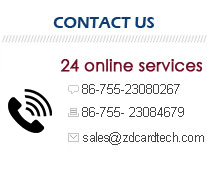In today’s digital era, businesses, schools, gyms, factories, and residential complexes all demand reliable and efficient security systems. Among the myriad options, the RFID Access Control System stands out for its unbeatable balance of security, convenience, and cost-effectiveness. At the core of this system lies a simple yet powerful tool: RFID proximity cards—the ultimate solution for streamlined entry and access management.
RFID (Radio Frequency Identification) proximity cards leverage wireless radio signals to identify and authenticate users. Each card integrates a tiny built-in chip and antenna, enabling seamless contactless communication with an RFID reader. When held near the reader (typically within 2–10 cm, depending on the type), the card instantly verifies the user’s identity and triggers access approval or denial—no physical contact or precise alignment required.
RFID proximity cards are categorized by their frequency bands, each tailored to specific use cases:
Low-Frequency (LF, 125KHz): The most basic and affordable option, widely used for simple access control (e.g., office entry). They have limited storage capacity (a few bytes) and short read ranges but excel in cost-sensitive scenarios.
High-Frequency (HF, 13.56MHz): A step up in security and functionality, with larger storage (up to several kilobytes) and support for encryption. Ideal for applications requiring multi-purpose use, such as gym memberships, campus IDs, and cashless payment integration.
Ultra-High Frequency (UHF, 860–960MHz): Designed for long read ranges (up to 10 meters) and fast batch scanning. Perfect for large-scale environments like parking lots, warehouses, and logistics facilities, where hands-free or remote identification is needed.
Applications of RFID Proximity Cards
RFID proximity cards are not limited to just “opening doors”—they integrate seamlessly into diverse environments to solve real-world access and management challenges:
1. Corporate Offices
Employees use a single RFID card to enter the building, restricted departments (e.g., server rooms), or meeting spaces. The system automatically logs entry/exit times, syncing with attendance software to eliminate manual timesheets and reduce administrative overhead.
2. Schools and Dormitories
Campus IDs with embedded RFID chips grant students access to dormitories, libraries, labs, and dining halls. Administrators can restrict access to sensitive areas (e.g., chemistry labs) and track campus movement for safety—critical for emergency response.
3. Gyms and Fitness Centers
RFID cards have become a staple in modern fitness spaces, enabling a “one-card-fits-all” experience:
Quick, queue-free entry through access gates.
Keyless access to smart lockers (no more lost keys or forgotten passwords).
Integration with on-site payment systems for drinks, snacks, or class sign-ups.
4. Factories and Warehouses
Manufacturers and logistics firms use RFID cards to limit access to production lines, inventory storage zones, and loading docks. This prevents unauthorized tampering with equipment or goods and ensures compliance with safety regulations (e.g., restricting non-essential personnel from hazardous areas).
5. Residential Complexes & Parking Lots
Residents use a single RFID card for building entry, elevator access to specific floors, and parking garage entry. The system eliminates tailgating (unauthorized entry behind a resident) and simplifies visitor management—guests can be issued temporary, time-limited cards.
Key Benefits of an RFID Access Control System
RFID proximity cards outperform traditional access solutions (e.g., keys, PIN pads) and even some advanced technologies (e.g., biometrics) by delivering four core advantages:
1. Enhanced Security
Unique Identification: Every RFID card has a non-duplicable unique ID (UID) stored on its chip. For HF/UHF cards, encryption (e.g., AES) adds an extra layer, making cloning nearly impossible.
Instant Deactivation: If a card is lost or stolen, administrators can remotely disable it via the system dashboard—preventing misuse within minutes (unlike keys, which require changing locks).
Auditable Trails: The system logs every access attempt (date, time, location, user), enabling quick investigations in case of security breaches.
2. Cost-Effective
Low Upfront Costs: RFID cards cost a fraction of biometric scanners or facial recognition systems. LF cards start at just $0.1–$3(Based on your customized content) each, while HF cards range from $0.1–$5(Based on your customized content)—bulk orders cut costs further.
Minimal Maintenance: Cards are durable (resistant to water, dust, and physical wear) and require no batteries. Readers and controllers have long lifespans, reducing replacement expenses.
3. User-Friendly
Hassle-Free Operation: Users simply tap or wave the card near the reader—no need to remember PINs or fumble with keys. This is critical for high-traffic areas (e.g., office lobbies at 9 AM) where speed matters.
Inclusive Design: Suitable for all users, including children (in schools) and seniors (in residential complexes), with no learning curve required.
4. Scalable and Flexible
System Integration: RFID access control easily connects with other tools, such as time-attendance software, payment gateways, and membership management platforms. For example, a gym’s RFID system can link card usage to workout data and billing.
Multi-Site Management: Administrators can manage access for multiple locations (e.g., a chain of offices or gyms) from a single cloud-based dashboard, updating permissions or deactivating cards globally.
Why Choose RFID Proximity Cards?
Beyond the core benefits, RFID cards stand out as the best access control solution for three unbeatable reasons:
High ROI: Low upfront investment combined with long-term savings (reduced labor, fewer security incidents, lower maintenance) delivers rapid returns—even for small businesses.
Universal Acceptance: RFID is a mature, widely recognized technology. Users already understand how to use it (e.g., contactless credit cards), eliminating training costs.
Proven Reliability: RFID systems operate in extreme temperatures, humid environments, and high-traffic settings without glitches. Unlike biometrics (which can fail due to wet fingers or poor lighting), RFID works consistently.
Frequently Asked Questions (FAQ)
Q1: How much do RFID access cards cost?
A1: Prices depend on frequency and features. LF cards cost $0.1–$3 each, HF cards $0.1–$5 each, and UHF cards $0.5–$10 each, all price based on your customized content. Bulk orders (1,000+) can reduce per-unit costs by 30–50%.
Q2: Can RFID cards be cloned?
A2: Basic unencrypted LF cards are vulnerable to cloning, but most modern systems use encrypted HF/UHF cards (e.g., MIFARE DESFire) that require specialized tools and access to encryption keys—making cloning impractical for most attackers.
Q3: Are RFID proximity cards only for access control?
A3: No—they are multi-purpose tools. In addition to access, they support time tracking, cashless payments (e.g., campus dining), locker management, and even library book checkout.
Q4: Is it complicated to install an RFID access control system?
A4: Not at all. A basic system requires three components: an RFID reader, a controller (to process data), and an electric lock. Installation takes a few hours for small spaces, and card management (enrolling new users, deactivating old ones) is done via a user-friendly software dashboard.
Q5: Are RFID systems suitable for small businesses?
A5: Absolutely. Small offices, boutique gyms, and apartment buildings benefit most from RFID’s affordability and simplicity. Systems can start with just one reader and scale up as the business grows.
Conclusion
In an era where security and convenience are non-negotiable, RFID proximity cards emerge as the most versatile, cost-effective, and reliable access control solution. Whether you’re managing a corporate office, a school campus, a gym, or a residential complex, RFID cards deliver enhanced security, streamlined operations, and a seamless user experience—all without breaking the bank.
As smart security becomes a necessity, not a luxury, RFID proximity cards aren’t just a “good choice”—they’re the best choice for future-proof access control.




